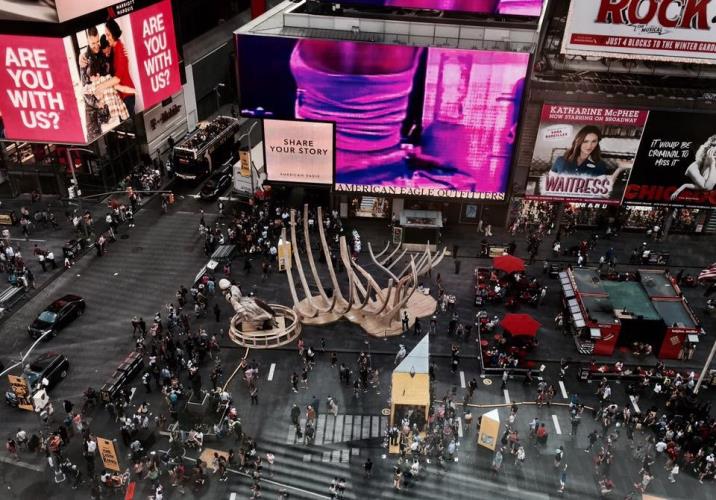Bachelor's degree with a double major in Chinese and Art in Peking University. Master of Art and Administration in New York University. She has served in the Macao Cultural Affairs Bureau, the New York City Department of Cultural Affairs and the Museum of Chinese in America, working as art administrator and curator. She is now working as an art educator and administrator in New York, as well as an independent curator and writer.

Times Square, New York. Photo taken by the writer in summer 2018.
There is no night in New York’s Times Square.
As night falls, the multifarious, saccharine billboards in Times Square strive to stand out from the crowd. At this crossroads of the world, from the costly billboards which charge by the minutes and seconds to the street artists in outlandish outfits, they all try their best to shine. Somehow, it is rather difficult to distinguish advertisements and entertainment from culture and arts.
It was right at this already─cramped square that a large wooden installation was suddenly introduced on a random summer’s day. Not only did it look like the skeleton of a marine mammal, but it also resembled the remains of a shipwreck. The installation formed a stark contrast to the surrounding buzz, with its wooden ribs stretching skywards and its contemplative female sculpture leading the armature. It was impossible for passers-by to miss.
The artist entitled the installation “Wake”. The female figurehead at the front of the ship is a replica of a sculpture which was used to decorate an American ship called “USS Nightingale” of the 19th century. The name “Nightingale” refers to Jenny Lind, a very popular opera star of the 19th century in the United States. She was also known as the “Swedish Nightingale” because of her origin and beautiful voice.
Maritime trade brought rapid development to New York’s economy in the 19th century, therefore the mooring of the clipper ship became an indicator of the development of economy and technology. At the same time, it had seen an increasing demand for culture and entertainment, and Jenny Lind turned out to be a vaunted celebrity. Subsequently, when a new clipper ship was put into service in 1851, Americans named it “Nightingale”. Unexpectedly, the “Nightingale” story did not end there: the ship was later used to transport African slaves, becoming part of black history in America. What’s more, it was employed again during the American Civil War, after which it served in Arctic expeditions and merchant trading until its foundering in 1893. The story ended when the “Nightingale” and its times had been sunken and swept away by the North Atlantic Ocean.
With the art installation, the artist wished to call forth a sunken era. Yet, his ambition goes beyond it, for “Wake” is only half of his entire installation. In the other half, he planned to make the submerged “Nightingale” once again “unmoored”. The artist then cooperated with a tech giant in developing a mobile application. Upon activation of the application, aim at the remains of the “Nightingale” with your mobile, and you will realise that the ship is gradually returning to its original state. When the whistle is blown, the “Nightingale” will set off again, sailing above Times Square and meeting various ships coming from different directions. What is sunken and flooded now, nevertheless, is the entire Times Square.
If “Wake” is summoning both the honour and disgrace in the history of New York City, then what has been indicated by the mobile-cum-reality virtual world is, sadly, the future of the city as a result of global warming… Guides were employed by the commissioned institution of the artwork to share the rationale of the installation with the passers-by. Some had mixed feelings after knowing the history behind it, while others simply marvelled at the virtual technology; some showed their concerns about global warming, while others did not wish to dive too deep with the political tussle behind such issues; some wanted to take a selfie in front of the installation while others, after walking for the whole day, only wished to take a rest on its base. The guides quickly learned when to explain and when to just simply click the shutter for the passers-by.
An interesting anecdote came when a guide finished giving the official explanation to a passer-by, and the latter said to her, quite unexpectedly, that the best thing about art is that it does not require any explanation, because it itself explains it all. The guide found the passer-by’s words more and more agreeable, and later when she was confronted with the question of what the installation is, she simply replied, “What do you think?”